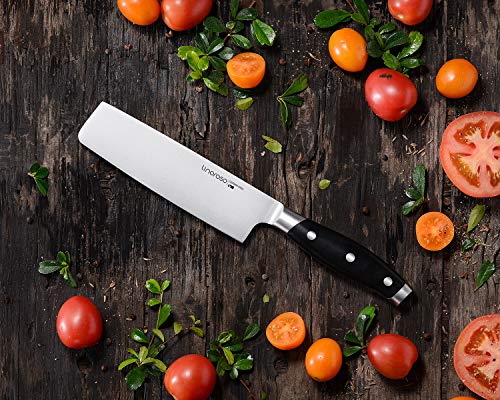You either know it, or you don’t, but even those with prior knowledge of this knife often ask, “what is a nakiri knife used for?” This question requires an in-depth response for you to truly know the various scenarios and best practices for the nakiri knife.
For those of you in a rush, the first section of this article should explain to a sufficient level the different cutting tasks you can use a nakiri knife for.
What is a Nakiri knife used for?
The nakiri knife is one of three major Japanese-style knives that makes up the core functionality of the all-purpose santoku knife. The other two are the gyuto and debi knives. As you can probably tell from its appearance, the nakiri knife works much like a mini Chinese cleaver knife and excels in chopping vegetables on a cutting board.
They design these knives with a straight edge and a rectangular blade that works best by cutting vegetables with a swift strike rather than a rocking motion.
Related: Nakiri vs. Santoku Knives
Origins
The nakiri bocho is a Japanese-style knife whose origins date back to Japan’s Edo Period during the 17th Century (1). This was when the Japanese government expanded trade routes with foreign nations, resulting in increased cultural goods.
Influenced by innovative designs of the outside world, blacksmiths decided to expand their range of traditional Japanese knives. That’s when the nakiri knife was born.
Since then, the nakiri knife has been a staple of the Japanese home, with homeowners using it to chop vegetables for everyday cooking. In fact, the name ‘nakiri’ literally means “leaf cutter,” highlighting its intended purpose.
Known for its long and flat edge, the nakiri knife based its design on the Western cleaver. However, it is made smaller and is focused on chopping greens.
Design
At first glance, the nakiri blade looks like a butcher’s cleaver knife, but it is more like a mini Chinese cleaver. The straight blade edge promotes chopping up vegetables via a swift up-and-down motion. In addition, the cutting edge is razor sharp with a thin blade that can pierce just about any vegetable on the chopping board, allowing you to get the job done in a single blow.
This Japanese vegetable knife is usually made of high-carbon stainless steel material. This enhances the knife’s edge retention properties. They are typically forged in full tang but can also be stamped as some brands offer cheaper alternatives.
The grip features an ergonomic handle usually made of a Japanese wood material such as Tagayasan or Pakkawood. In addition, the design often features a rounded tip at the butt of the handle.
The nakiri knife features a double-beveled blade that excels in retaining its edge through a symmetrical design that evenly applies the knife’s weight. The benefit of the double bevel edge is that you can be a little more reckless with your cutting, and the blade will not chip or crack under pressure.
Furthermore, the extremely thin blade means you get a cleaner cut with your vegetables, rather than ripping the skin, which often occurs with a thicker blade.
Materials
A typical nakiri knife blade’s materials are forged carbon steel with a high chromium content that resists rust and corrosion. One usually makes them in full tang construction. They harden the blade to about 60 HRC on the Hardness Rockwell Scale.
Encompassing a good balance of strength, durability, and edge retention, the nakiri knife is also sharpened to a razor-sharp edge of 10-15 degree blade angles per side.
Like many traditional Japanese kitchen knives, the nakiri features vintage-style wooden handles. In addition, it has a rounded tip for a gorgeous aesthetic and a decent grip. Many Western knife brands incorporate their handle designs to enhance the ergonomics of the handle, usually featuring synthetic polyoxymethylene materials.
A Western grip often comes with a safety finger lock and triple rivets. So, combining this with the prowess of the sharp and durable Japanese blade is an absolute winner.
Other versions of the nakiri knife feature an all-steel handle with a beautifully modern look that complements any home decor and interior design. In addition, these nakiri knives are often dishwasher-friendly because of the high chromium content shared between the blade and handle.
In conclusion, nakiri knives have a strong foundation and a sharp edge that lasts a long time. The broad rectangular blade and D-shaped handle allow you to cut vegetables in a single strike.
Best uses for Nakiri knives
The best way to get the most out of the nakiri knife is to do exactly what the blade was named after, cutting greens! Unlike other knives, the nakiri has a unique knife design. In the shape of a broad rectangle, it gives you more backbone to complement your cutting motion.
So when preparing stir-frys or roast dinners, use the nakiri knife’s straight cutting edge to slice up the potatoes. You can also use them on pumpkins and chop and dice tomatoes and onions.
Unlike the chef’s knife, the nakiri specializes in vegetable-related cutting tasks. This is because they do not come with curved blade edges like Western meat cleavers, and the nakiri’s blade is generally much thinner and sharper, making it ideal for handling delicate vegetables.
Indeed, the best thing you can do for yourself is to resist the urge to use your nakiri as a meat cleaver. Despite their similar appearance, think of it as a vegetable cleaver instead.
Knowing what to cut is only sometimes enough, so we must go over the things you should not cut with a nakiri knife. Despite its resemblance to Western meat cleaver knives, the nakiri is strictly a vegetable knife. You should avoid cutting meats, fish, and bread when using a nakiri knife. These can compromise the blade’s edge.
Related: Best Cleaver Knife
Care and Maintenance
One of the most important things to remember with razor-sharp blades like the nakiri knife is that its cutting prowess will only last for a while. Basically, the sharper and thinner the blade, the faster it will dull, simply because of its greater fragility and thinner edge.
Fortunately, the nakiri knife is one of the easiest blades to sharpen because of its straight edge and lengthy measurements.
I recommend sharpening your nakiri knife as often as possible, such as after every few cutting sessions. You can sharpen your nakiri knife using a sharpening stone, usually purchased from the brand you purchased your knife from.
Brands such as Cutco or Shun give their customers a ‘forever sharpness guarantee’ upon purchasing their products. This allows you to have your knife resharpened for free when it goes dull.
Unlike the average Japanese knife, the nakiri has a wide rectangular blade closer to the Chinese-style cleaver knife. As such, handwashing your nakiri knife requires more time and effort.
First, use warm water and a light soap or detergent to lather the blade and handle. Then, apply a cleaning cloth to wipe the whole knife down from top to bottom.
Excessive use of your kitchen knife not only results in a blunt tip but can also compromise the shape and symmetry of the blade. The same rule applies to the nakiri knife, so it is worth investing in a honing steel rod to maintain the edge.
This is because honing steel rods are like filing your fingernails, whereas a sharpener is like a nail clipper (2).
Nakiri knife vs Usuba knife
The usuba knife is quite similar to the nakiri knife; at first glance, it is hard to tell the difference. However, the first thing to remember is that usuba knives are primarily used by professional chefs. On the other hand, most people predominantly use the nakiri knife in household kitchens. This is because they are taller in the handle.
It allows chefs to do hours and hours of chopping large vegetables while keeping their hands out of harm’s way.
Japanese cuisine typically consists of vegetables, fish, and meat combined with a foundation of rice, noodles, and soup. The concept of the usuba knife is the same as the nakiri knife. Their primary function is to take care of the vegetable side of Japanese cooking. The nakiri and the usuba knife are similar in their purpose, and both excel at delivering a clean cut.
Another key thing to remember is that the usuba knife is a little heavier than the nakiri knife, albeit mostly because of its longer length. Furthermore, the single bevel “kataba” style of the blade’s edge requires more skill than nakiri knives.
There are also many variations of the usuba knife. These include the Kanto variation, which features a flat tip, and the Kamagata style, which has a spine dropping down towards the edge.
Ultimately, the difference in design between the nakiri and usuba is so subtle and only really applies to your environment and mode of use. However, the chopped food achieved using the usuba knife consists of more precise cuts than the nakiri knife because of its single-bevel knife blade.
As such, professional chefs across Japan see greater benefits in using this type of knife. It allows them to be more precise in their slicing, which ultimately enhances the presentation of their dishes.
Buying guide
Nakiri knives can be purchased through just about any Japanese-style knife manufacturer, though they are rare among Western brands. I recommend brands like Shun and Miyabi for the best nakiri knives. Particularly if you are after the traditional D-shaped handle design.
Wusthof’s classic nakiri is an amazing knife with a Western-style riveted handle. It delivers full tang forged durability, razor-sharp cutting edge, and an ergonomic handle with a finger safety lock.
When buying the nakiri Japanese kitchen knife, some things to remember are the blade’s material, construction, handle material, and design.
The best nakiri knife features a forged full tang design made of high carbon stainless steel with a good amount of chromium for moisture resistance. In addition, durability and edge retention are the key properties to look out for. Like most Japanese knives, the nakiri is sharpened to a steep 10-15-degree edge angle and comprises a thinner blade.
Related: Shun Knives Review
What is a nakiri knife used for FAQ
What is a Nakiri knife good for?
A nakiri knife is great for taking on any vegetable-related chopping task, as it has a wide frame and sharp cutting edge. In addition, the D-shaped handle provides excellent ergonomics. A single strike helps get the knife and vegetables down to the chopping board under your control.
Related: Nakiri vs. Santoku Knives
Is it worth having a Nakiri knife?
The nakiri is a favorite knife among homeowners. However, you probably won’t contemplate its value until you’ve used it. The multi-purpose chef and santoku knives are widely used for vegetable-cutting tasks. Still, the nakiri offers a specialization that far surpasses the realm of multi-use knives.









